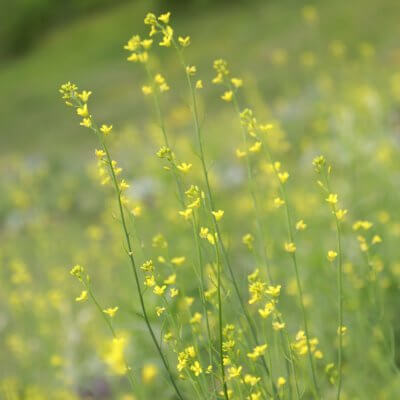Meadow Mayhem
In 2017, the first annual Botanical Garden Summer Camp program took place in amid an artfully designed meadow. The square-in-square design allowed children to experience a sense of wildness, no matter how contrived. The planting also added benefit of putting nitrogen and biomass back into the soil throughout the growing season, a critical process after compaction incurred during construction. Here are seven beautiful, functional plants that form this matrix of floral diversity.
1. Brassica juncea ‘Brazen Brass’ (Brazen Brass brown mustard)
 Even the phrase mustard greens keeps all the attention on the foliage, which is handsome enough. The overlooked flowers supply nectar to upwards of 30 different pollinators.
Even the phrase mustard greens keeps all the attention on the foliage, which is handsome enough. The overlooked flowers supply nectar to upwards of 30 different pollinators.
2. Emilia javanica (tassel flower)
 This reseeding annual is a new staff favorite at the Botanical Garden thanks to its carefree personality. Those firecracker orange sparks mingle playfully with everything from grains to greens in the meadow matrix.
This reseeding annual is a new staff favorite at the Botanical Garden thanks to its carefree personality. Those firecracker orange sparks mingle playfully with everything from grains to greens in the meadow matrix.
3. Fagopyrum esculentum (buckwheat)
 Ever wondered where those delectable buckwheat pancakes came from? Buckwheat flour comes from the ground seeds of this beautiful, fragrant, pollinator-attracting flower which, despite its common name, has stronger allegiances to rhubarb and sorrel than wheat.
Ever wondered where those delectable buckwheat pancakes came from? Buckwheat flour comes from the ground seeds of this beautiful, fragrant, pollinator-attracting flower which, despite its common name, has stronger allegiances to rhubarb and sorrel than wheat.
4. Pennisetum purpureum ‘Tift 8’ (Graceful Grasses® Vertigo® fountaingrass)
 At nearly 6 feet tall the richly colored blades of this fountaingrass vibrates throughout the design, the kind of botanical percussion that keeps a steady, unifying beat.
At nearly 6 feet tall the richly colored blades of this fountaingrass vibrates throughout the design, the kind of botanical percussion that keeps a steady, unifying beat.
5. Crotolaria juncea (sunn hemp)
 As of July, this legume is a bit player, barely distinguishable as functional or ornamental. But by season’s end, it will flower robustly in yellow and have contributed dozens of pounds of nitrogen back to this plot.
As of July, this legume is a bit player, barely distinguishable as functional or ornamental. But by season’s end, it will flower robustly in yellow and have contributed dozens of pounds of nitrogen back to this plot.
6. Lobularia ‘Inlbusnopr’ (Snow Princess® sweet alyssum)
 This trademarked hybrid is an extremely vigorous annual, used here as a groundcover reminiscent of how its parents might grow in the wild: in cloudy drifts tumbling down seaside cliffs. Insert your ocean here.
This trademarked hybrid is an extremely vigorous annual, used here as a groundcover reminiscent of how its parents might grow in the wild: in cloudy drifts tumbling down seaside cliffs. Insert your ocean here.
7. Centaurea cyanus ‘Blue Boy’ (Blue Boy bachelor’s buttons)
 What’s not to love about a smattering of cornflower blue bachelor’s buttons in high contrast to a blurry haze of yellow everything else? These cottage favorites are old-fashioned and familiar.
What’s not to love about a smattering of cornflower blue bachelor’s buttons in high contrast to a blurry haze of yellow everything else? These cottage favorites are old-fashioned and familiar.







